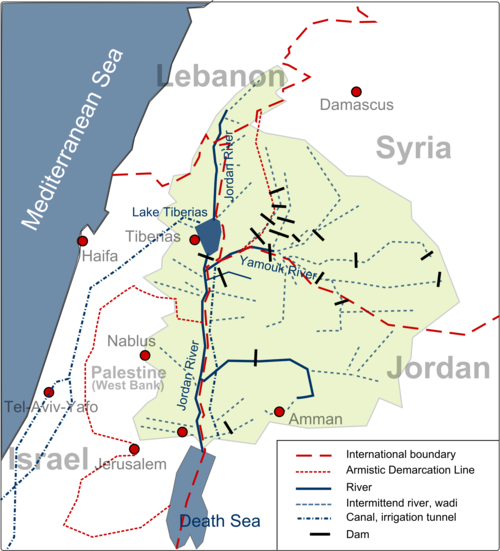The Jordan River headwaters (Hasbani, Banias and Dan) are fed by groundwater and seasonal surface runoff. The Lower Jordan River originally received its main inflow from the outlet of Lake Tiberias and the Yarmouk River, the largest tributary, as well as from several wadis and aquifers. The flow of the Upper Jordan River into Jordan River Basin Lake Tiberias remains nearly natural, but flow rates in the downstream part of the river have decreased sharply in the last 50 years due to the construction of a series of infrastructure and diversion schemes established in the basin.
The current annual discharge of the Lower Jordan River into the Dead Sea is estimated at 20-200 MCM (million cubic meters) compared to the historic 1.300 MCM. Moreover, water quality in the Lower Jordan River is very low.
Palestine and Syria have no access to the Jordan River; hence their use of water resources from the river itself is nil. However, Syria has built several dams in the Yarmouk River sub-basin, which is part of the Jordan River basin. Israel is the largest user of water from the Jordan River basin.
Since the early 20th century, numerous attempts to foster cooperation between basin riparians have been hampered by the regional political conflict which continues to stand in the way of any basin-wide agreement on water. A number of bilateral agreements encourage cooperation over water between Israel and Jordan, and Israel and Palestine.
Main Agreements
Jordan - Syria
1953 and 1987 – On the use of the Yarmouk River, including the construction of the Wahdah Dam and 25 dams in Syria. The agreement also establishes a joint commission for the implementation of the provisions on the Wahdah Dam.
Israel - Jordan
1994 – Annex II of the Treaty of Peace concerns water allocation and storage of the Jordan and Yarmouk Rivers, and calls for efforts to prevent water pollution as well as the establishment of a Joint Water Committee.
Israel - Palestine (PLO)
1995 – Article 40 of the Oslo II political agreement states that Israel recognizes Palestinian water rights in the West Bank only and establishes the Joint Water Committee to manage West Bank waters and develop new supplies. Palestinians are denied access to the Jordan River under this agreement.
Key Concerns
Water Quantity
Ensuring adequate quantities of water for all riparians is a key challenge in the basin given the relatively small volume of water available and the large population. River flow has been greatly reduced over the years as a result of increased exploitation of water resources in the basin. The rapid decline of the Dead Sea is an indicator that the region's ecosystem is at risk.
Water Quality
Water quality rapidly deteriorates along the course of the Jordan River and its lower portion displays extremely high salinity and pollution rates.
Geopolitical
The question of water sharing in the Jordan River basin is inextricably linked to the ongoing conflicts between Israel and Syria, Israel and Lebanon, and Israel and Palestine, and while a wide range of issues are at stake, control over water in the basin has added to existing regional tensions.
